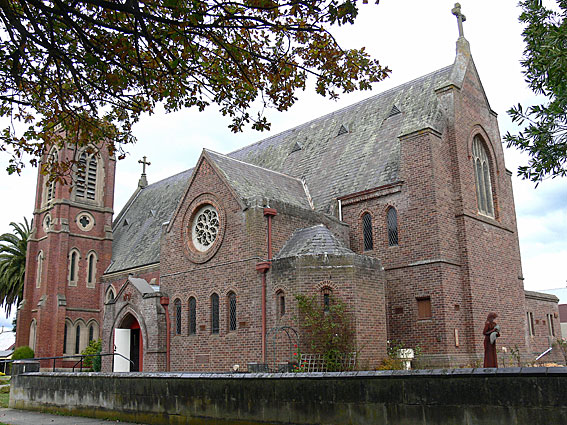
St John's Anglican Church, Colac: exterior view from the south-east
[photograph by John Maidment (2008)]

St John's Anglican Church, Colac: exterior view from the south-east
[photograph by John Maidment (2008)]
Historical and Technical Documentation by John Maidment
© OHTA, 2020 (last updated October 2020)
The first Anglican church in Colac was opened on 8 May 1870.1 The foundation stone of the present church was laid on 19 July 1889. The architects were Tappin , Gilbert & Dennehy and it was built in brick on stone and concrete foundations with a slate roof. It was designed to seat 250 people, it measured 50 x 30 feet, and the cost was envisaged as around £2,000.2 The building was opened on 24 June 1891.3 It was considerably extended in 1933 to the design of Louis R. Williams. The additions consisted of a lofty chancel and sanctuary, organ chamber, apsidal side chapel and vestries.4 Sadly the envisaged spire was not completed.
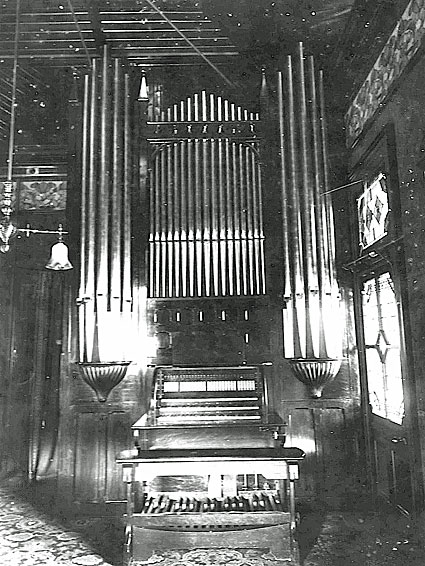
The Frederick Taylor organ when installed at the residence of F.H. Wilson, St Kilda
[photograph from the collection of John Maidment, ex Charles Stickland (1909-1919)]
The present organ was built around 1909 by Frederick Taylor for the residence of Frederick Hamilton Wilson, 149 Alma Road, East St Kilda.5 Wilson was a partner in the firm of Wilson, Bishop & Henderson, public accountants and auditors. It was placed in a large and lofty room with stained glass windows.6 The design of the organ incorporated a number of string registers – Taylor had moved the Casson's Patent Organ Company instrument from the residence of William Winter-Irving in Armadale to Christ Church, Hamilton in 1904 and could have taken advantage of the scales. It also included "ad libitum" pistons set by a button above the relevant stopkey. The so-called Portunal on the Choir Organ was a rare example of a triangular wooden flute.
| GREAT Open Diapason Stopped Diapason Gamba Principal Suabe Flute Swell Sub to Great Swell to Great Swell Octave to Great Choir to Great |
8 8 8 4 4 |
||
| SWELL Lieblich Bourdon Geigen Principal Lieblich Gedact Viol d'Orchestre Voix Celeste Geigen Principal Hohl Flute Oboe Sub Octave Octave Tremulant |
16 8 8 8 8 4 4 8 |
A TC |
|
| CHOIR (enclosed) Salicional Portunal Dulciana Gemshorn Vox Humana Swell to Choir Tremulant |
8 8 8 4 8 |
||
| PEDAL Bourdon Lieblich Bourdon Great to Pedal Swell to Pedal Choir to Pedal |
16 16 |
A |
Compass: 61/30
Tubular-pneumatic action
Attached stopkey console
Balanced swell pedals
Thumb pistons & composition pedals7
Height 15 feet; width 10 feet 6 inches; depth 10 feet with console.8
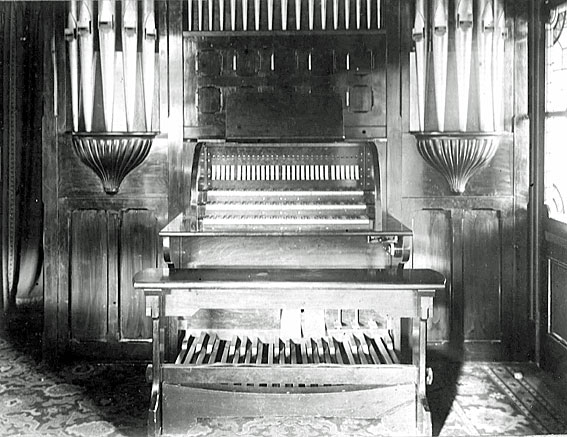
The Frederick Taylor organ – console
[photograph from the collection of John Maidment, ex Charles Stickland (1909-1919)]
In 1919 the organ was acquired by Charles Stickland and placed in his home at 115 Miller Street, North Fitzroy.9 He sold the instrument to St John's Church, Colac in early 1924 at a total cost of £1300; it was opened on 22 May 1924 by Dr A.E. Floyd, from St Paul's Cathedral, Melbourne.10
The instrument was moved at the time of the completion of the building in 1934 into a new organ chamber on the north side of the chancel (possibly by Taylor).
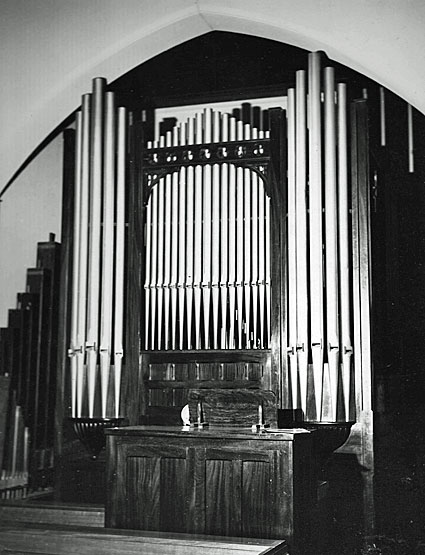
The organ at St John's Church, Colac before the rebuild
[photograph by Robert Tobin (1966)]
It remained unaltered until it was rebuilt in 1971 by Laurie Pipe Organs. The action was electrified, the number of manuals reduced to two, the Great Organ redesigned as a three-rank division. Some original pipework was sadly lost in the process.

The organ at St John's Church, Colac after the Laurie rebuild
[photograph by John Maidment (2008)]
| GREAT Double Diapason Open Diapason Stopped Diapason Dulciana Octave Suabe Flute Twelfth Fifteenth Swell Sub Octave to Great Swell to Great Swell Octave to Great |
16 8 8 8 4 4 2-2/3 2 |
A B A B A A |
|
| SWELL Geigen Diapason Lieblich Gedeckt Salicional Octave Gemshorn Nazard Hohl Flute Tierce Oboe Sub Octave Octave Tremulant |
8 8 8 4 2-2/3 2 1-3/5 8 |
TC |
|
| PEDAL Subbass Bourdon Principal Flute Great to Pedal Swell to Pedal |
16 16 8 8 |
C A B C |
Great & Pedal Pistons
Compass: 61/30
Electro-pneumatic action
Detached stopkey console11
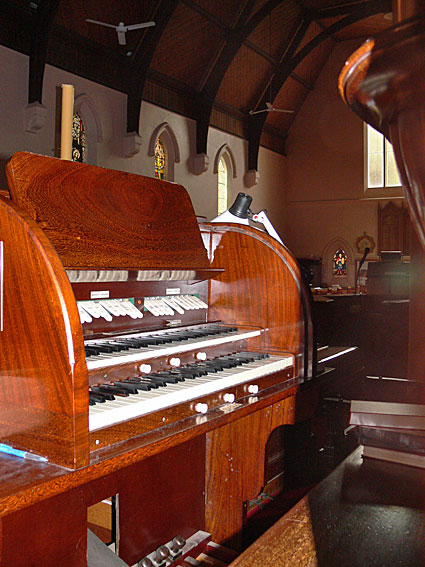
St John's Church, Colac – console after the rebuild
[photograph by John Maidment (2008)]

St John's Church, Colac – interior looking east
[photograph by John Maidment (2008)
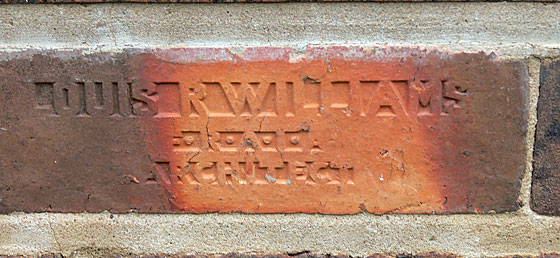
St John's Church, Colac – Louis Williams signature brick
[photograph by John Maidment (2008)]
1. St John's Church of England, Colac 1870-1930: Diamond Jubilee, p.1
2. Colac Herald, 19 July 1889, p.2
3. Ibid., 23 June 1891, p.3
4. The Argus, 26 October 1933, p.13
5. E.N. Matthews, Colonial Organs and Organbuilders (Carlton: Melbourne University Press, 1969), p.183 – information ex Charles Stickland
6. Address and Wilson details from Sands & McDougall Melbourne Directory 1910 and photograph of organ in house
7. Specification noted by John Maidment January 1966
8. Dimensions of organ from. Matthews, op.cit.
9. Ibid., and Sands & McDougall Melbourne Directory 1920
10. St John's Church of England, Colac 1870-1930: Diamond Jubilee, p.19
11. Specification noted by John Maidment 1971